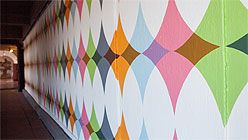Beginning the exhibition season at SFAI’s Walter and McBean Galleries, Glen Helfand and Cydney M. Payton have curated a tight group show of pre-existing and newly commissioned work by both local and international artists. Temporary Structures fits well within the poured-concrete gallery space, referencing immediate architectural features alongside far-flung Parisian or Brazilian constructions. Highlighting artists’ interventions into and visions of built spaces, the exhibition is playful and engaging, representing a variety of media and approaches to all things transitory.
Works made for the exhibition include Jonathan Runcio’s Pie in the Sky, a grid-like wooden structure that divides the main gallery in half and supports flatworks focused on a former element of the SFAI building. The Brutalist portion of the campus (as opposed to the original 1926 Mission-style building) was designed by architect Paffard Keatinge-Clay in 1969. Original plans for the school’s cafeteria included a second-story extension that materialized as far as its wooden framework before influential neighbors complained about the building’s height. In framed blueprints and screenprints on metal, Runcio repeats the image of the unrealized angular add-on, willing its memory into being, a commemoration of the unrealized.

Jonathan Runcio, Pie in the Sky.
Amy M. Ho, Up/Down.This careful attention to the surrounding physical space is represented with visual immediacy by Amy M. Ho’s Up/Down, a three-part projection on the gallery’s central staircase. A still image of angled stairs is projected onto the face of the landing, easily seen during a walk through the gallery. Corresponding images are nearly hidden underneath the same concrete protrusion. Though they require crouching to be seen, these two smaller projections reward viewers with ingenious angled mirror set-ups that are both delightful and effective.
Dispersed across the gallery are reminders of previous installations and wall-painted renderings of the architect’s original plans. Small black and white photographs show Paul Kos’ 1985 piece Gargoyles VIII, in which a man free-climbed a vaulted arch cut into the gallery walls. The framed photos hang beside the recently uncovered arch. Similarly, David Ireland’s 1987 Smithsonian Falls, Descending a Staircase for P.K. is memorialized just at the top of the stairs he once covered in a flood of concrete.

Paul Kos, Gargoyles VIII.
David Gissen, The Mound of Vendôme.David Gissen continues this theme of residue with a museological display documenting his proposed monument The Mound of Vendôme. In 1871, when the Parisian Communards toppled the Vendôme Column as a symbol of imperialist power, they cushioned the tower’s fall with a mound of hay, sand, and urban detritus meant to protect the surrounding buildings from dangerous vibrations. Following the suppression of the Commune in 1873, the column was rebuilt. In a petition to the Director of Heritage and Architecture, Gissen calls for the reassembly of the mound as well. Were this temporary structure, he argues, to become permanent, it would prioritize Communard history alongside imperial history, demonstrating the Communard’s interest in preserving their city within their revolutionary ideals.




